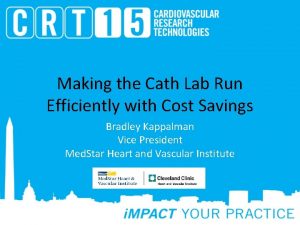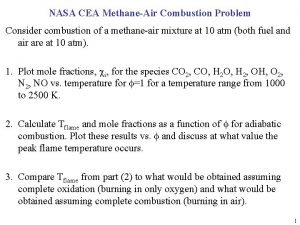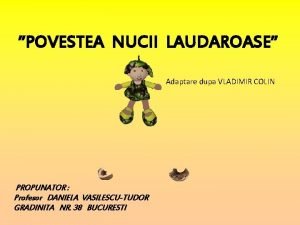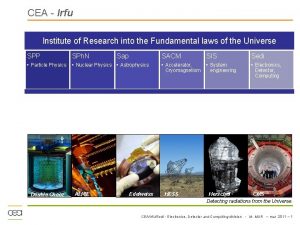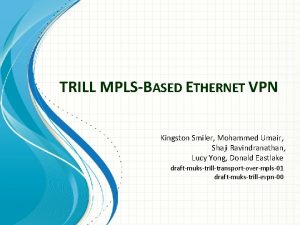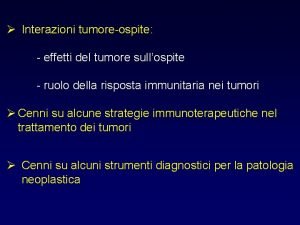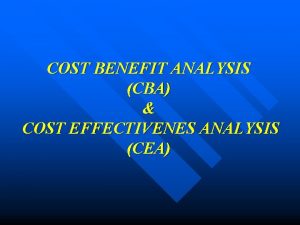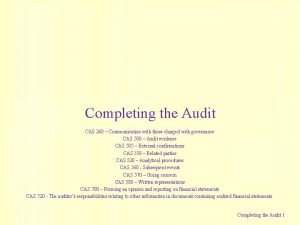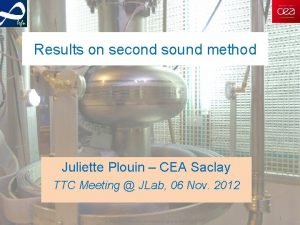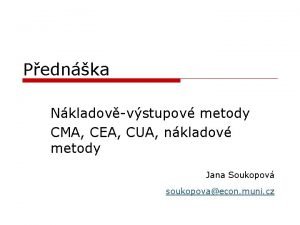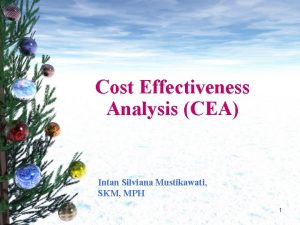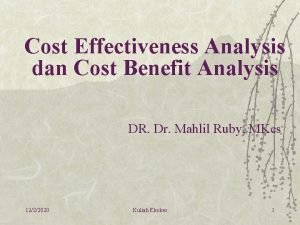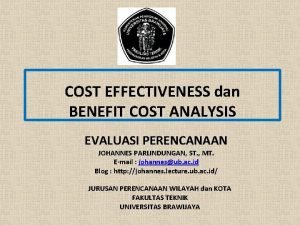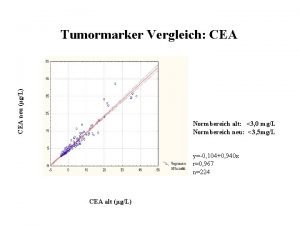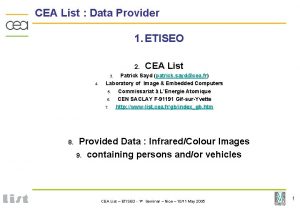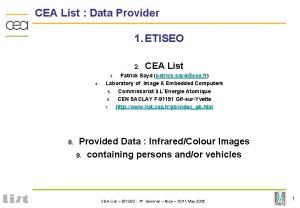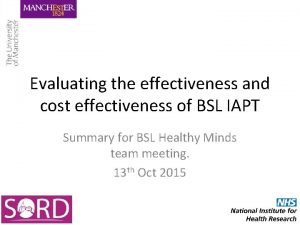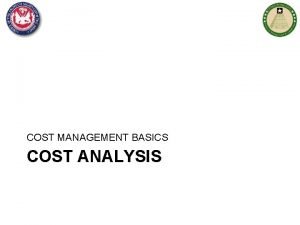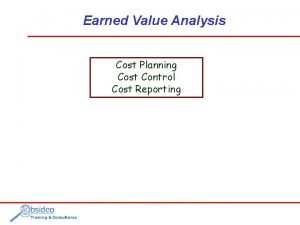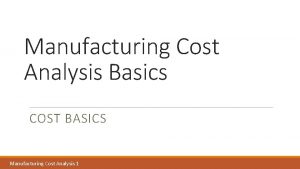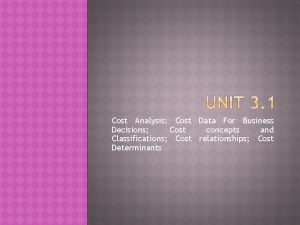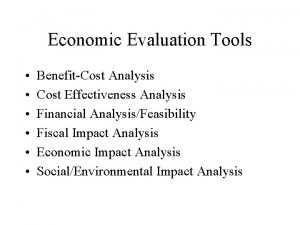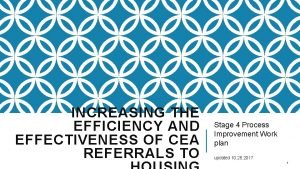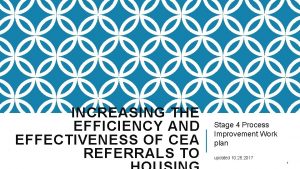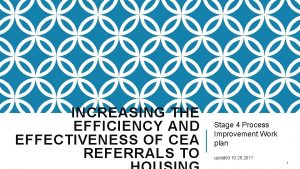Cost Effectiveness Analysis CEA and its Role in
































- Slides: 32

Cost Effectiveness Analysis (CEA) and its Role in the US Healthcare System Presented by Kenice Frank Advised by Peter Neumann, Sc. D in completion of the Harvard Health Policy Summer Program

INTRODUCTION

• Harvard Center for Risk Analysis (HCRA) l The Cost Effectiveness Analysis (CEA) Registry provides public electronic access to a comprehensive database of costeffectiveness ratios. Its goals are to find opportunities for targeting resources to save lives and improve health and to move towards standardization of cost-effectiveness methodology in the field.

Specific Objectives: 1. Create a comprehensive database of CUAs 2. Catalogue the methods used and examine whether studies have been improving 3. Construct a league table of cost/QALY ratios that adhere to Panel recommendations 4. Expand the above to include CEAs that report outcomes in terms of cost per life year gained (LY) PHS 398/2590 ( Rev. 05/01)

Importance of the CEA Registry l Is the quality of reporting in published CUAs improving? l Are pharmaceuticals costeffective? • Are studies adhering to recommended protocols? • Which cancer prevention and treatment interventions are most cost-effective?

Definitions l Cost Utility Analysis (CUA) -a form of economic analysis used to guide procurement decisions, especially health technology assessment (HTA) - cost is measured in monetary units; the item being considered needs to be expressed in a quantitative form l Sensitivity Analysis (SA) -aims to ascertain how the model depends upon the information fed into it, upon its structure and upon the framing assumptions made to build it. http: //en. wikipedia. org/wiki/Costutility_analysis

Definitions l Incremental Analysis – a method used to analyze the difference between the intervention and the alternative treatments l Discounting – a method used to adjust future costs and benefits to their market value; people prefer things now instead of later http: //en. wikipedia. org/wiki/Costutility_analysis

What is CEA? l CEA is a systematic method of comparing two or more alternative programs by measuring the costs and consequences of each. l The health outcomes of all the programs to be compared must be measured in the same common units l Cost Utility Analysis (CUA) -a form of economic analysis used to guide procurement especially health technology assessment (HTA) - cost is measured in monetary units; the item being considered expressed in a quantitative form l Sensitivity Analysis (SA) -aims to ascertain how the model depends upon the information upon its structure and upon the framing assumptions made to build it. Berger et al. , 2003 decisions, needs to be fed into it,

Timeline project timeline Month Upgrade of Website and Restructuring of Database Assessment of User Needs and Website Evaluation Gather user feedback on beta test of website 23 ( July 2005) Revise website based on beta test 24 (August 2005) Evaluate website performance 22 ( June 2005) Website Maintenance and Integration of New Data Outreach and Public Dissamination New data acquisition and integration Drafting of newsletter Revision of documentation

Limitations l The life expectancy alone does not take into account the quality of additional time that is gained This is why we use QALYs

QALYs l QALY = Quality Adjusted Life Year l Advantages: 1. Capture gains from prolongation and improved quality of life in a single measure 2. Incorporate the value or preferences people place on different outcomes 9/10/2020 Drummond et al. , 1997

00/ 0, 0 $10 Increases costs Intervention is less effective and more costly QA LY The Impact of a Technology on Costs and Health LY A /Q 00 , 0 $20 Increase in QALYS Decreases costs Intervention is more effective and less costly $ Laupacis A. et al. , Can Med Assoc J 1992; 146: 475

Why CEA? l Despite the United States’ resistance to CEA, it has still emerged as the recommended technique for conducting economic evaluation of health and medical interventions l CEA’s rising popularity can be easily noticed by the rising numbers of CEA publications being made in mainstream medical journals.

Why CEA? l The mere presence of this type of increase indicates a system that is in need of CEA’s services. Figure 1: Growth in Published Cost-Utility Analyses, 1976 -2001 Source: CUA Registry, Harvard School of Public Health, as of February 2003.

METHODS

CEA Registry Process

Phase III Data Collection l Screening Out l Readers fill out a Methods, Ratios and Weights form for each article to extract the data that will go into the database

Phase III Data Collection Methods Form • intervention types • form completion • prevention stage • cost measurements • primary affiliation of author(s) • reporting of results • study sponsorship/funding • perspective • discounting • sensitivity analysis • discussion section

Phase III Data Collection Ratios Form l l l l l target population intervention comparator $/QALY from article population size impact in $ ratio uncertainty direct medical costs non-health care costs $/QALY intervention comparator

Phase III Data Collection Preference Weights Form l l l l secondary data usage population sample size elicitation method(s) health state weight range total # of weights

RESULTS

Cost-Utility Analyses Of Pharmaceuticals Published, Phase II (1998 -2001) Updated by Kenice Frank using Phase II data

Interventions Type Frequencies Updated by Kenice Frank using Phase II data

Updated by Kenice Frank using Phase II data


Average acceptable median CE ratio is $50, 000/QALY • incremental cost of more than $50, 000/QALY gained = rejected • incremental cost of less than or equal to $50, 000/QALY gained = accepted Updated by Kenice Frank, using Phase 2 information

DISCUSSION

Problems in CEA

References l l l Neumann, P. J. (2005). using cost-effectiveness analysis to improve health care. New York, Oxford Press. ISPOR (2003). Health care, cost, quality and outcomes. Lawrenceville, ISPOR. Neumann, P. J. , E. A. Sandberg, et al. (2000). "Are Pharmaceuticals Cost-Effective? A Review of the Evidence. " Health Affairs 19(2). Neumann, P. J. (2002). "The Quality and Usefulness of Pharmacoeconomic Studies for Drug Coverage Decisions. " Pharmaceutical News 9(1): 15 -20. Neumann, P. J. (2004). "Why Don't Americans Use Cost. Effectiveness Analysis. " The American Journal of Managed Care 10(5): 308 -312.

Acknowledgements • • • HCRA Peter Neumann, Sc. D. Jenny Palmer, M. S. James Fraumeni, A. B. Joshua Cohen, Ph. D. Adi Eldar-Lissai, MBA HMS – Joan Reede, M. D. , M. PH, M. S. – Binta Beard, M. S. – Xue Fen Su, M. S. – Jo Cole AND National Library of Medicine

Questions or Comments? ?

Thank You!! Enjoy the rest of the presentations!
 Cath lab cost effectiveness
Cath lab cost effectiveness Materiality constraint adalah
Materiality constraint adalah Cost behavior and cost-volume-profit analysis
Cost behavior and cost-volume-profit analysis Azure worker role
Azure worker role Adjectiv pronominal de departare
Adjectiv pronominal de departare Cea mai importanta sarbatoare crestina
Cea mai importanta sarbatoare crestina Cea nasa
Cea nasa Sceneta de 8 martie flori pentru mama
Sceneta de 8 martie flori pentru mama Cea mai longeviva pasare
Cea mai longeviva pasare Cea vega media molina de segura
Cea vega media molina de segura Prima fotografie color
Prima fotografie color Cea mai mica unitate de masura a informatiei
Cea mai mica unitate de masura a informatiei Nuca cea laudaroasa
Nuca cea laudaroasa Tipurile comunicarii
Tipurile comunicarii Irfu cea
Irfu cea Cea clean room
Cea clean room Bts radioprotection
Bts radioprotection Vpn ssl cea
Vpn ssl cea Snowfall torrente
Snowfall torrente Plante i
Plante i Cea
Cea Ag carcino embrionale cea
Ag carcino embrionale cea Cea
Cea Esclerotomos occipitales
Esclerotomos occipitales Perbedaan cba dan cea
Perbedaan cba dan cea Cea.cas700.com
Cea.cas700.com Cea
Cea Cea nedir
Cea nedir Cea juliette
Cea juliette Biology
Biology Regina cea rea
Regina cea rea Cua vs cea
Cua vs cea Perbedaan cba dan cea
Perbedaan cba dan cea
